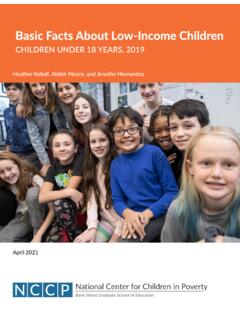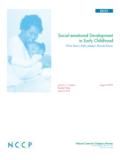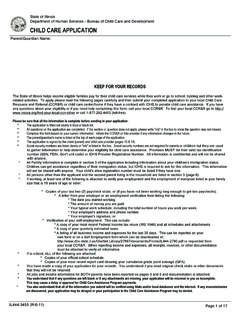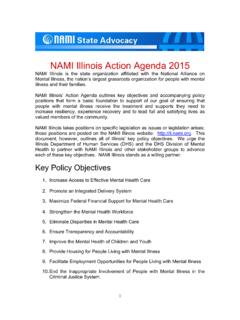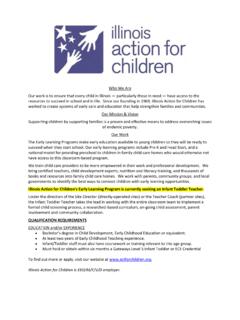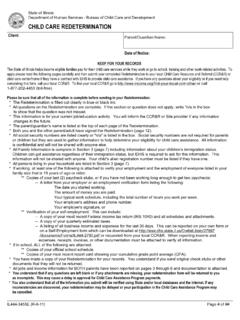Transcription of Linking Home-Based Child Care And State-Funded Preschool
1 Patti Banghart, J. Lee Kreader National Center for children in Poverty Nicole Forry, Rachel Anderson, Martha Zaslow, Alison Chrisler Child Trends Linking Home-Based Child Care And State-Funded Preschool : The Community Connections Preschool Program ( illinois action for children ) Evaluation Phase 1 Implementation Study May 2011 illinois action for children is a catalyst for organizing, developing and supporting strong families and powerful communities where children matter most. It engages organizations and individuals statewide to advocate for public policies that benefit children and families. In the Chicago area, its programs reach more than 100,000 children each year through Child care resource and referral services, Child care assistance payments, Child nutrition programs, Child care quality improvement services, early childhood education, home visiting, parent leadership training, and community-building activities.
2 Informed by its grassroots membership and program participants, the organization s public policy and program development work reflects the priorities of those most directly affected. This report was completed for illinois action for children with funding from the Annie E. Casey Foundation. Additional support was provided through the illinois Early Childhood Block Grant, administered by the illinois State Board of Education. Other Acknowledgements In addition to the authors listed on this report, Tom Layman and Tasha Gill, both from illinois action for children , served as active members of the project team, providing valuable insights into the program history, context, and implementation. The project team would like to acknowledge the individuals who made this study possible through their assistance with the recruitment, consent, and data collection processes. These individuals include Maria Rios and Tiffany West, who assisted with recruitment; Diana Brown, Aminah Wyatt, Patti Banghart, and Louisa Higgins, who conducted observations of Home-Based providers; Toni Porter and Carol Begnoche who trained the observers to reliability on the Child Care Assessment Tool for Relatives (CCAT-R); and Meagan McSwiggan, Katie Sidorowicz, and Shannon Moodie, who conducted interviews with parents, center directors and teachers, and illinois action for children program coordinators.
3 In addition, the project team would like to thank the parents, Home-Based providers, center teachers and directors, and Community Connections program coordinators who generously shared their time, experiences, and recommendations. Suggested Citation: Forry, N., Anderson, R., Banghart, P., Zaslow, M., Kreader, , & Chrisler, A. (2011). Linking Home-Based Child Care and State-Funded Preschool : The Community Connections Preschool Program ( illinois action for children ). Evaluation Phase 1 Implementation Study. Prepared for illinois action for children , Chicago, IL. Table of Contents Introduction .. 1 Introduction to the Community Connections Program Model .. 1 Community Connections Program Evaluation: Phase I Implementation Study .. 2 Report Overview .. 2 Context .. 3 Study Methodology .. 4 Sample Recruitment .. 4 Sample Description .. 6 Description of Centers and Home-Based Settings .. 7 Recruitment Procedures .. 8 Interview Content .. 8 Observations of Home-Based Care.
4 9 Results .. 9 Respondent Groups Overall Reactions to the Community Connections Program .. 9 Reaching Unserved children .. 11 Quality of Home-Based Settings: CCAT-R .. 12 Respondents Perceptions of How Well the Program Was Addressing Articulated Strategies .. 14 Key Components of the Program Model .. 17 Community Connections Preschool Key Components .. 18 Summary and Recommendations .. 23 Summary of Key Findings from the Phase 1 Implementation Study .. 24 Program Elements about Which Respondent Groups Consistently Showed Awareness .. 26 Program Elements for Which Further Specification Would Be Helpful .. 27 Challenges in Implementing the Program Model Where Further Training or Resources Would be Helpful .. 27 Recommendations for Next Steps .. 28 References .. 30 Appendices .. 31 Appendix : IAFC Coordinator Interview Protocol .. 32 Appendix : Center Director Interview Protocol .. 39 Appendix : Center Teacher/Assistant Teacher Interview Protocol .. 43 Appendix : Home-Based Provider Interview Protocol.
5 48 Appendix : Parent Interview Protocol .. 53 Appendix : CCAT-R Results: Caregiver and Child Language and Engagement 56 Appendix : CCAT-R Results: Health and Safety .. 57 Appendix : CCAT-R Results: Materials .. 58 Appendix C: Home-Based Provider Visit Record .. 59 Appendix D: Center Visit Form .. 61 Page 1 Introduction Introduction to the Community Connections Program Model The Community Connections Preschool program (herein referred to as Community Connections) was developed to help prepare children in Home-Based Child care for success in school and in life. It has three goals: (1) to make state prekindergarten classroom experiences available to children in Home-Based care, (2) to extend classroom learning experiences in the Home-Based care setting, and (3) to support infant and toddler development in participating providers homes. In this model, state prekindergarten ( illinois Preschool for All ) classrooms provide half-day sessions four days per week for 3- and 4-year-old children coming from Home-Based Child care.
6 On the fifth day, the teachers visit children s care providers; delivering books and educational materials, modeling ways to extend curriculum activities, and discussing children s learning in the classroom. While preschoolers are in classrooms away from the Home-Based care setting, providers have precious time to focus on the needs of infants and toddlers in their care. illinois action for children (herein referred to as IAFC) created the Community Connections program model in 2005 as illinois was rapidly expanding its state prekindergarten program, which would ultimately change from serving exclusively at-risk children to become Preschool for All. As the Preschool for All program grew, it became clear that large numbers of preschoolers in Home-Based care were being left out. Home-Based care is the only option for many parents in low-wage jobs because those jobs tend to require non-traditional work hours evenings, weekends, and changing shifts when Child care centers are closed.
7 In illinois , 67% of low-income single mothers with children under six work non-traditional hours ( illinois action for children , 2006). These mothers overwhelmingly choose Home-Based Child care, usually provided by family, friends and neighbors. According to illinois Child Care Assistance Program data, among families using the Child Care Assistance Program in Cook County, 58% have enrolled their children in Home-Based Child care (22% in licensed homes and 36% in license-exempt Family, Friend and Neighbor care). While Home-Based Child care is a significant community asset, Preschool -age children tend to learn cognitive school readiness skills best in classroom settings (National Institute of Child Health and Human Development Early Child Care Research Network, 2002). In 2005, IAFC developed Community Connections to support Home-Based Child care while adding a classroom-based experience to the children s day. This new program represents a third model through which state prekindergarten services are delivered in illinois .
8 The two most common models are part-day school-based programs and full-day programs delivered in conjunction with Child care centers. As a third model, Community Connections has the potential to reach a large population of unserved children . Page 2 Community Connections Program Evaluation: Phase I Implementation Study The illinois State Board of Education has requested evidence that the Community Connections mixed model works before making funding available for it statewide. Education agencies in other states are expected to ask the same question. Community Connections is a mixed model, incorporating classroom-based and home-provider-based elements. As such, it represents a significant departure from the common state prekindergarten models, which are entirely classroom-based. While research conducted on Early Head Start and Parents as Teachers models has suggested that specific mixed models are effective ( Department of Health and Human Services, 2006; Parents as Teachers National Center, 2007), IAFC and its state education agency are seeking evidence specific to the Community Connections model.
9 In Phase 1 of a two phase evaluation, IAFC asked Child Trends and the National Center for children in Poverty (NCCP) to conduct a study to examine model clarity, fidelity, and the implementation of Community Connections. Phase 2, to take place after implementation issues are identified and addressed, will be an outcomes study. Report Overview This report describes the methodology and presents the findings of Phase 1 of the evaluation of the Community Connections model, the implementation study. Central to the methodology, described in detail below, were comprehensive interviews with members of the five groups participating in, or connected through, Community Connections: the complete cadre of Preschool for All coordinators at IAFC, as well as samples of participating center directors, classroom teachers and assistant teachers, Home-Based care providers, and parents of participating children . In addition to interviews, quality observations were conducted with the Home-Based providers in their care settings, with each observation focused on a Child participating in Community Connections.
10 Review of participation data maintained by IAFC informed selection of the centers for the study, as well as the range of Home-Based providers affiliated with those centers from which to recruit the sample. As described more fully later, recruitment efforts were successful with licensed providers, all of whom were English-speaking, but not with license-exempt providers, who may have felt uncomfortable being The results section of the report opens by summarizing the reactions, which were predominately enthusiastic, to participating in Community Connections from the coordinators, center directors, center teachers, home providers, and parents; as well as their impressions, also heavily favorable, of the model and its benefits to them and their children . This section goes on to review interview responses and program documents for insights into how well the model is achieving its first goal: making Preschool classroom experiences available to children who would not otherwise have them.

